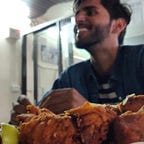Why every Pythonista must-read “Automate the boring stuff with Python”?
Bible for Python Programmers!
If not the most, Python is definitely one of the most loved programming languages. It is simple, easy to understand, and can come handy on multiple occasions. Whether you are handling the backend of a website, building a new game, analyzing data for a company, or creating a machine learning model, Python does everything for you.
When someone gets into Python world. I have seen newbie programmers getting excited for a few days. They ask for books, resources, enroll in courses, and whatnot. They want to become the new “van Rossum” in a month or two. But, this is not how it goes! You have to be consistent with the language.
Python is simple and amazing at the same time. All you have to do is stay consistent and grow with the learnings. And, there is one such book which will enhance your Python learning. Surely, there are hundreds of books on Python. But, none can match the aura of this hefty book.
Automate the boring stuff with Python!
Just read it thoroughly. Perform the tasks and get along with the examples consistently. You will get handsome knowledge of Python and how it does amazing things in a matter of seconds.
Content
- Chapter 1 — Python Basics
- Chapter 2 — Flow Control
- Chapter 3 — Functions
- Chapter 4 — Lists
- Chapter 5 — Dictionaries and Structuring Data
- Chapter 6 — Manipulating Strings
- Chapter 7 — Pattern Matching with Regular Expressions
- Chapter 8 — Input Validation
- Chapter 9 — Reading and Writing Files
- Chapter 10 — Organizing Files
- Chapter 11 — Debugging
- Chapter 12 — Web Scraping
- Chapter 13 — Working with Excel Spreadsheets
- Chapter 14 — Working with Google Spreadsheets
- Chapter 15 — Working with PDF and Word Documents
- Chapter 16 — Working with CSV Files and JSON Data
- Chapter 17 — Keeping Time, Scheduling Tasks, and Launching Programs
- Chapter 18 — Sending Email and Text Messages
- Chapter 19 — Manipulating Images
- Chapter 20 — Controlling the Keyboard and Mouse with GUI Automation
This 20 chapters long book cum thesis sheds light on every possible subject of Python. It all starts with the basics where you get to learn basics, if/else statement, loops, data structures, reading and writing files, and strings. There is a lot of exercises you can do after finishing the chapters and make your base strong.
Things get a bit tense when the book introduces us to regular expressions, that are used mostly in password pattern matching or email format checkers. There is a whole chapter dedicated to debugging. So, you can cross-check or debug your code and make it bug-free.
As you keep on turning pages and getting along with the book, you bump into one of the coolest things Python can do i.e web scraping. After that, the book lets you work with Excel, Json, PDF files using Python. These lessons mainly shed light on extracting data in any format just using Python script.
The last few chapters take automation to a whole new level. You can send emails using Python scripts. Not only emails but also SMS. You can play with the images and work on GUI automation.
If not deep, but you get a rough idea of how things are done with Python. You cannot remember every library or every module used in this book. But, at least you get to know how to work with them. And, if you study this book sincerely, you will get a lot to learn. Even if you give it your 70–80%, you will get handsome knowledge of Python and its use cases with the libraries.
What did I love about this book?
I got into Web Scraping due to this book!
My favorite chapter in this book was one where I got to work with BeautifulSoup. Then, I scraped many tables from the websites and worked a lot on that skill.
This book introduced me to Selenium and I ended up creating a Twitter Bot, YouTube song player.
Using the Twilio library to send texts to mobile or using the smptlib library to send emails using python scripts, all of it I learned was from this very book.
Python is not limited to the stuff that is taught in this book. There are many brilliant books written on Python and its use cases. But, no book can give you the overall exposure to the language like this one.
So, what are you waiting for? If you are new to Python, get this book. It is freely available. If you lie in the category of experienced Pythonistas and haven’t read this book, you should also take out some time and read it.
References:
Peace!
